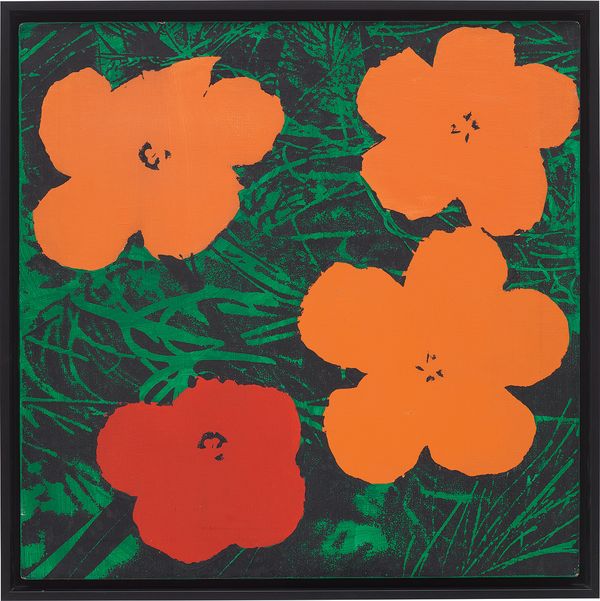Sturtevant Warhol Flowers, 1969. Estimate: £125,000-180,000.
20th Century & Contemporary Art Day Sale at Phillips London, 14 February.
When Andy Warhol was once questioned about the artistic method behind his Flowers, it has been said that he responded, "I don't know. Ask Elaine" (Sturtevant, in Bill Arning, "Sturtevant," Journal of Contemporary Art, no. 2, Fall/Winter 1989, p. 44). Indeed, shortly after Warhol took the art world by storm with his dazzling silkscreen paintings of hibiscus flowers, (Elaine) Sturtevant conceived her own radical response to the Pop master’s new body of work: using a 22 x 22-inch silkscreen that Warhol had lent her, Sturtevant created her seminal body of work Warhol Flowers, of which other examples reside in such institutions as The Art Institute of Chicago. Executed in 1965 and 1969, respectively, the two present examples are situated at the dawn of Sturtevant’s radical conceptual practice that would see her use some of the most iconic artworks of her generation as a source and catalyst to explore notions of originality, authorship and authenticity.
Sturtevant’s Warhol Flowers are the result of a masterful loop of repetition, one in which the artist pushed Warhol’s very own artistic investigations into new conceptual pastures. Warhol had, indeed, taken as his source for a photograph by Patricia Caulfied that was published in the June 1964 Modern Photography, cropping the rectangular image of seven flowers to a square containing only four blossoms. As Peter Eleey noted, "In Sturtevant’s hands, Warhol’s image draws greater attention to the limits, edges, and qualities of his authorship, already stressed by the appropriated and delegated aspects of his screenprint paintings’ manufacture…while pointing back further to the woman whose image had passed from her own camera, through Kodak’s advertising agency, to a magazine, and then to a high-contrast crop at Warhol’s Factory, before moving to his screen maker, and finally on to Sturtevant" (Peter Eleey, Sturtevant, Double Trouble, exh. cat., Museum of Modern Art, 2014, p. 49).
The brutal truth of the work is that it is not a copy. The push and shove of the work is the leap from image to concept. The dynamics of the work is that it throws out representation.
— Sturtevant
Sturtevant Warhol Flowers, 1965. Estimate: £125,000-180,000.
While engaging in strategies of appropriation, Sturtevant notably goes beyond merely questioning the discourse of original and copy. It is telling that rather than revisiting the masterpieces of the distant past, Sturtevant turned to the "masterpieces" in the making around her. Her first-ever solo exhibition, at the Bianchini Gallery in New York in 1965, presented a tongue-in-cheek installation that effectively put the art world’s latest fashions on display. Merely a year after the debut of Warhol’s Flowers at Leo Castelli Gallery, Sturtevant lined the gallery walls with her own Warhol look-a-likes – here juxtaposed with a white sculpture resembling a work by George Segal shown pulling a garment rack laden with paintings evocative of works by the likes of Jasper Johns, Arman, Claes Oldenburg and Frank Stella. In doing so, Sturtevant effectively exposed the political, economic and cultural circumstances that underpin art’s creation, circulation, consumption and canonization. For Sturtevant, the 1960s represented "the big bang of pop art. But pop only dealt with the surface, I started asking questions about what lay beneath the surface. What is the understructure of art? What is the silent power of art?" (Sturtevant, quoted in conversation with Peter Halley, Index Magazine, 2005, online).
While works such as the present ones at first glance appear as "perfect copies," they are best understood as studies that expose broader systems of value within the art world. "By faking faking," Peter Eley has argued, "she showed that she was not a copyist, plagiarist, parodist, forger, or imitator, but was rather a kind of actionist, who adopted style as her medium in order to investigate aspects of art’s making, circulation, consumption, and canonization" (Peter Eleey, Sturtevant: Double Trouble, exh. cat., The Museum of Modern Art, New York, 2014, p. 50).
Since her passing in 2014, Sturtevant has received the critical attention she was denied for much of the late 20th century. After receiving the Golden Lion Lifetime Achievement award at the 2011 Venice Biennale, her work was celebrated in her first comprehensive survey in the United States since 1973 beginning at The Museum of Modern Art, New York in 2014.

